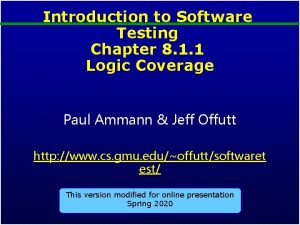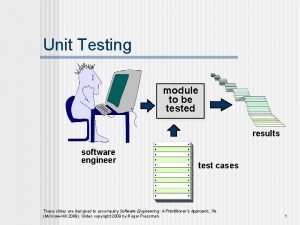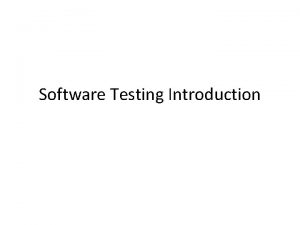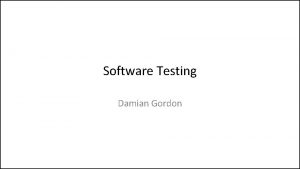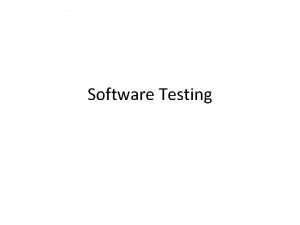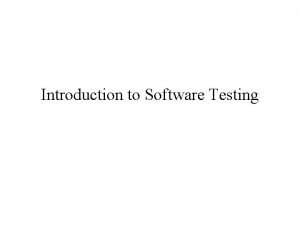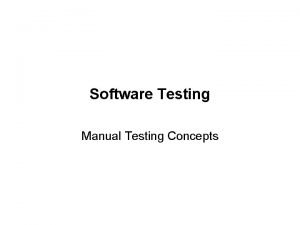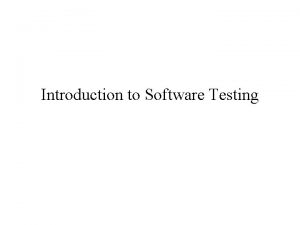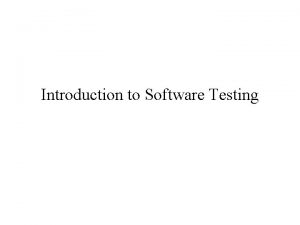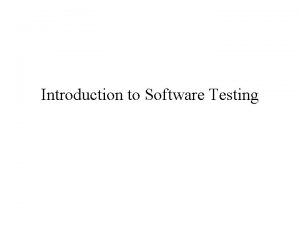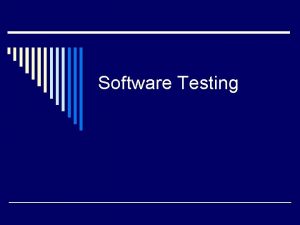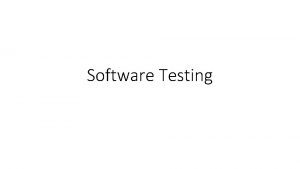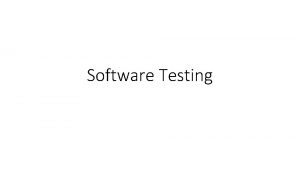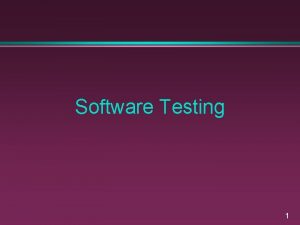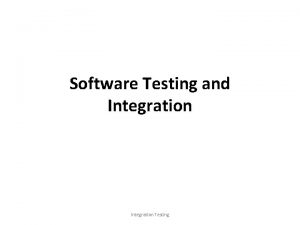UNIT 4 Software Testing Introduction Software Testing is
















- Slides: 16

UNIT – 4 Software Testing

Introduction Ø Software Testing is evaluation of the software against requirements gathered from users and system specifications. Ø Testing is conducted at the phase level in software development life cycle or at module level in program code. Ø Software testing comprises of Validation and Verification.

Software Verification Ø Verification is the process of evaluating products of a development phase to find out whether they meet the specified requirements. Ø Verification answers the question– “Are we building the system right? ” Ø Verification ensures the product being developed is according to requirement and design specifications. Ø Verifications concentrates on the design and system specifications. Ø Verification is carried out before the Validation.

Software Validation Ø Validation is process of examining whether or not the software satisfies the user requirements. Ø Validation answers the question – " Are we building the right system? ". Ø It is carried out at the end of the SDLC. Ø Validation ensures the product under development is as per the user requirements. Ø Validation process describes whether the software is accepted by the user or not.

Manual Vs Automated Testing Ø Manual - This testing is performed without taking help of automated testing tools. Ø The software tester prepares test cases for different sections and levels of the code, executes the tests and reports the result to the manager. Ø Manual testing is time and resource consuming. The tester needs to confirm whether or not right test cases are used. Ø Automated This testing is a testing procedure done with aid of automated testing tools. Ø The limitations with manual testing can be overcome using automated test tools.

Black-box testing Ø It is carried out to test functionality of the program. Black box testing means functional test. Ø It is also called “Behavioral testing”. Ø The tester in this case, has a set of input values and respective desired results. Ø On providing input, if the output matches with the desired results, the program is tested ‘ok’, and problematic otherwise. Ø In this testing method, the design and structure of the code are not known to the tester. Ø Testing engineers and end users conduct this test on the software.

Black-box testing techniques: Ø Equivalence class - The input is divided into similar classes. If one element of a class passes the test, it is assumed that all the class is passed. Ø Boundary values - The input is divided into higher and lower end values. If these values pass the test, it is assumed that all values in between may pass too. Ø Cause-effect graphing - In both previous methods, only one input value at a time is tested. Cause (input) – Effect (output) is a testing technique where combinations of input values are tested in a systematic way. Ø Pair-wise Testing - The behavior of software depends on multiple parameters. In pair wise testing, the multiple parameters are tested pair-wise for their different values. Ø State-based testing - The system changes state on provision of input. These systems are tested based on their states and input.

White-box testing Ø It is conducted to test program and its implementation. Ø It is a testing method based on information of the internal logic of an application’s code. In order to improve code efficiency or structure. Ø Tests are based on coverage of code statements, branches, paths, conditions. Ø It is also known as ‘Structural testing’. Ø In this testing method, the design and structure of the code are known to the tester. Software developers are responsible for doing White Box Testing.

White-box testing techniques: Control-flow testing – Ø The purpose of the control-flow testing to set up test cases which covers all statements and branch conditions. Ø The branch conditions are tested for both being true and false, so that all statements can be covered. Data-flow testing – Ø This testing technique emphasis to cover all the data variables included in the program. Ø It tests where the variables were declared and defined and where they were used or changed.

Testing Levels Ø Testing itself may be defined at various levels of SDLC. Ø The testing process runs parallel to software development. Ø Before jumping on the next stage, a stage is tested, validated and verified. Ø Testing separately is done just to make sure that there are no hidden bugs or issues left in the software. Ø Software is tested on various levels – Ø Unit Testing Ø Integration Testing Ø System Testing Ø Acceptance Testing Ø Regression Testing

Unit Testing Ø While coding, the programmer performs some tests on that unit of program to know if it is error free. Ø Testing is performed under white-box testing approach. Ø Unit testing helps developers decide that individual units of the program are working as per requirement and are error free. Integration Testing Ø Even if the units of software working fine individually, there is a need to find out if the units if integrated together would also work without errors.

System Testing Ø The software is compiled as product and then it is tested as a whole. This can be accomplished using one or more of the following tests: Ø Functionality testing - Tests all functionalities of the software against the requirement. Ø Performance testing - This test proves how efficient the software is. It tests the effectiveness and average time taken by the software to do desired task. Performance testing is done by means of load testing and stress testing where the software is put under high user and data load under various environment conditions. Ø Security & Portability - These tests are done when the software is meant to work on various platforms and accessed by number of persons.

Acceptance Testing Ø When the software is ready to hand over to the customer it has to go through last phase of testing where it is tested for user-interaction and response. This is important because even if the software matches all user requirements and if user does not like the way it appears or works, it may be rejected. Ø Alpha testing - The team of developer themselves perform alpha testing by using the system as if it is being used in work environment. They try to find out how user would react to some action in software and how the system should respond to inputs. Ø Beta testing - After the software is tested internally, it is handed over to the users to use it under their production environment only for testing purpose. This is not as yet the delivered product.

Regression Testing Ø Whenever a software product is updated with new code, feature or functionality, it is tested thoroughly to detect if there is any negative impact of the added code. This is known as regression testing.

Definition or Meaning Software quality assurance – Ø These are software development process monitoring means, by which it is assured that all the measures are taken as per the standards of organization. Ø This monitoring is done to make sure that proper software development methods were followed. Software quality control – Ø This is a system to maintain the quality of software product. Ø It may include functional and non-functional aspects of software product, which enhance the goodwill of the organization. Ø This system makes sure that the customer is receiving quality product for their requirement and the product certified as ‘fit for use’.

Definition or Meaning Software audit – Ø This is a review of procedure used by the organization to develop the software. Ø A team of auditors, independent of development team examines the software process, procedure, requirements and other aspects of SDLC. Ø The purpose of software audit is to check that software and its development process, both conform standards, rules and regulations.
 Functional testing vs unit testing
Functional testing vs unit testing Domain testing
Domain testing Motivational overview in software testing
Motivational overview in software testing Du path testing
Du path testing Globalization testing
Globalization testing Cause effect graph for triangle problem
Cause effect graph for triangle problem Control structure testing in software engineering
Control structure testing in software engineering Decision table testing in software testing
Decision table testing in software testing Decision table testing example
Decision table testing example Limited entry decision table
Limited entry decision table Rigorous testing in software testing
Rigorous testing in software testing Testing blindness in software testing
Testing blindness in software testing Domain example
Domain example Introduction software testing
Introduction software testing Introduction to software testing exercises solutions
Introduction to software testing exercises solutions Module testing in software engineering
Module testing in software engineering Embedded software unit testing
Embedded software unit testing














